The term “small form factor” (often called SFF), encompasses a large variety of small PC builds. You’ll often also hear terminology thrown around like mini-ITX and sandwich case, and even PC sizes being measured in litres! Let’s go over all of these terms.
Jump to a section
Common SFF Layouts
▪️ Compact
▪️ Sandwich
▪️ Vertical sandwich
▪️ Mini sandwich
▪️ Ultra slim
Measuring size in litres
SFF motherboard sizes
▪️ Mini ITX
▪️ Micro ATX
▪️ Mini DTX
Ready to choose an SFF PC?
SFF PC case volume and layout
The two key specifications of a SFF case are usually it’s internal layout (how do the components fit?) and it’s volume (how much space does it take up?).
Common SFF layouts
Compact
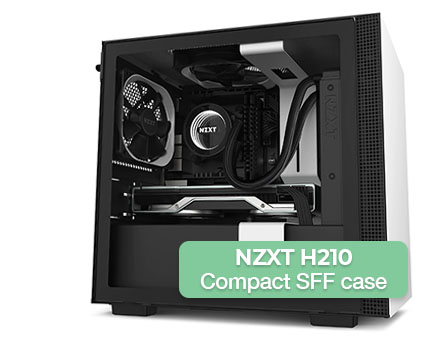
A compact SFF case is essentially a shrunken-down version of a classic PC tower case.
What’s different? These will only support a mini-ITX (or sometimes micro-ATX motherboard), as opposed to a full-sized ATX motherboard on other PC tower cases. Sometimes the power supply (PSU) is relocated from the top or bottom of the case, into a location at the front of the case, in order to reduce vertical case height.
What’s the same? It still supports fitting a graphics card directly into the slot (that is, without the use of a PCIe riser cable). Usually it also has sufficient room to install a CPU tower cooler and extra fans. Compact cases often support full-sized ATX power supplies as well as SFX-sized power supplies.
Why go with a compact SFF? Compact cases are an inherently simpler layout which makes it easier to build than other SFF layouts. It also favours the use of tower coolers, which can also help reduce the cost of building the PC (as an alternative to more expensive water-cooling solutions).
Why not go with a compact SFF? There aren’t any major downsides to a compact SFF layout. However, they tend to be inherently larger than sandwich SFF layouts because the graphics card must be mounted horizontally, which makes compact layouts wider than most sandwich cases.
Sandwich
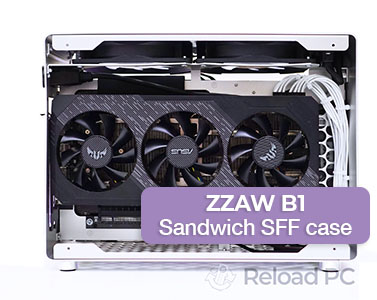
A sandwich SFF case further reduces the vertical height of a case, by relocating the graphics card to be behind the motherboard. This gives sandwich cases their distinctive brick-like appearance, as they are longer than they are tall. Their proportional dimensions means sandwich cases tend to appear narrower than compact SFF cases.
Key features: The case has two compartments, separated by a “spine” vertically along the middle of the case. A PCIe riser cable connects the two compartments, so that the graphics card rests on the back half of the case can be connected to the motherboard and CPU on the front half of the case. Due to the long length of the case, a big advantage is that sandwich cases can usually support full-length graphics cards that have 3 fans and are larger than 30cm in length, while being smaller than compact SFF cases. Due to the proportions of the case, sandwich SFF cases are often seen as being more aesthetically pleasing compared to compact SFF cases.
Commonly seen: Most common sandwich SFF cases provide room above the case to mount a 240mm or 280mm radiator and fans, which are used in AIO (all-in-one) water coolers. All side panels on the case are usually perforated with many holes to allow airflow on both sides, to allow all components on both sides to breathe freely. Air is then usually exhausted through fans at the top of the case.
Constraints: Usually, only mini-ITX motherboards and SFX-sized power supplies are supported in sandwich cases, as sandwich cases optimise their space efficiency around these standardised sizes. There are also usually less places to place fans, as the case is narrower than the typical PC case. Some limited or exclusive sandwich cases will be so small that they only support smaller 92mm or 80mm fans (rather than the common 120mm and 140mm fans).
Vertical sandwich
A vertical sandwich case is taller but thinner than usual, and makes good use of vertical space. Often, it’s simply a sandwich case which has been rotated 90 degrees to be vertical. As well as taking up less surface space on your desk, a vertical sandwich case is very distinctive and often starts a conversation!
Mini sandwich
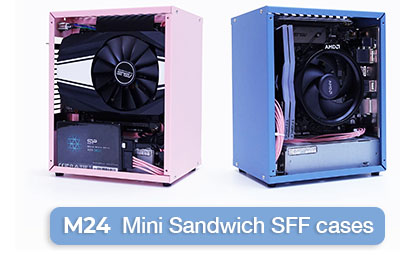
A mini sandwich case takes the sandwich concept further, by using a Flex ATX-sized power supply and limiting the length of the graphics card.
Benefits: These are the ultimate in portability and extremely tiny in size! These cases can reach new lows in volume – some even dropping under 5L while still supporting mid-ranged graphics cards like the RTX 3060Ti. This makes it possible to put an entire powerful gaming PC into a backpack!
Disadvantages: The small size will require compromise and will prevent you from using certain hardware. The CPU cooler must be a low profile cooler, which limits how powerful of a CPU you can use. Usually, only graphics cards up to 180-200mm long are supported, depending on the case. As a result, as of the date of writing this article, the most powerful graphics card to fit mini sandwich layouts is the RTX 3060Ti. Additionally, Flex ATX power supplies are usually not rated to a high power draw (typically for consumer use, ~500W) and/or they have small, very noisy cooling fans (which you may not realise until you start stressing the system).
Ultra slim
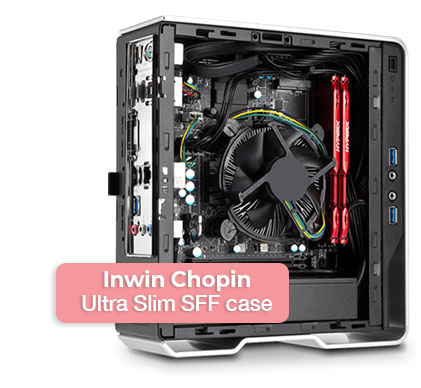
An ultra-slim case forgoes the graphics card, and simply contains motherboard-mounted components and a power supply. The power supply is either Flex ATX-sized, or it may be external in the form of a laptop-style power adapter.
Limitations: Without a graphics card, gaming performance is limited, and these ultra-slim SFF PCs are often intended for productivity and professional work. However, gaming may be possible with certain chips like AMD Ryzen APUs. Cases options for ultra-slim are relatively scarce, and your choice of internal hardware is very limited. This size is commonly seen with pre-built office PCs from Dell, HP, etc but those PCs usually cannot be customised to any meaningful degree.
Measuring size in litres
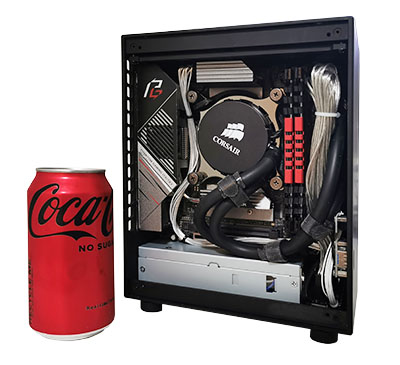
We often refer to SFF case sizes in litres. It’s just a convenient way to get an idea of the footprint of a case, although the number itself may be confusing if you haven’t encountered it before! Some ways to think about it are:
- A typical soft drink can is 200-375 mL
- A sub-5L SFF case is really small. They’re usually around 20cm in height, in the mini-sandwich format
- A 10-15L SFF case is usually a sandwich case. As described above, they’re usually brick-like in shape
- A compact SFF case is usually under 20L
- Anything larger than that - it’s hard to call it a “SFF” case!
To calculate the volume of a case,
- Find its height, width and length in centimetres (cm) e.g. H=20cm, W=15cm, L=40cm
- Multiply these three numbers together e.g. 20x15x40 = 12,000 cubic centimetres (cm^3)
- Divide by 1,000 given that 1 cubic centimetre (cm^3) = 1 millilitre (mL)
SFF motherboard sizes
Mini ITX
Mini ITX motherboards are supported in virtually all SFF cases. It is one of the three most common motherboard sizes, along with full ATX and micro ATX (mATX). A mini ITX motherboard is square-shaped at 17cm by 17cm. Notably, mini ITX motherboards usually only support 2 DIMMs of RAM (two RAM slots) and only have 1 single PCIe x16 lane, so it means you may only connect one graphics card directly onto the board. Many boards (especially mid-to-higher range motherboards) also contain two M.2 slots, which allows for two storage drives to be connected directly into the motherboard.
Since 2020, almost all motherboard manufacturers have a full lineup of mini ITX motherboards, and you should easily be able to find a mini ITX motherboard that supports your desired CPU. However, mini ITX motherboards, due to their density and their position as an “enthusiast” motherboard, will almost always cost more than mATX or full ATX versions.
Sometimes, mini ITX is abbreviated to “mITX”, but it is also often referred to simply as “ITX”. This is a byproduct of history, as mini ITX is the only variant of the ITX size standard that is in widespread use today (as opposed to the ATX standard, which all the larger motherboard sizes are based on).
Micro ATX
Micro ATX (abbreivated mATX) motherboards can be thought of as a four-slot version of a full ATX motherboard. It’s in between full ATX and mini ITX. The maximum height and width of micro ATX is 24.4cm, however some mATX motherboards are a little smaller.
Mini DTX
Mini DTX motherboards are essentially taller mini ITX motherboards. They are extremely rare, as there is only one board on the consumer market currently in this size, being the Asus Crosshair VIII Impact, a board for AMD CPUs. This motherboard has utilised the extra space to allow for a high-end audio chipset.
Ready to choose an SFF PC?
At Reload PC, we’re small-form-factor experts and we’ll build and deliver the SFF PC you’re looking for, whether it’s for portable work purposes, or pint-sized desktop gaming. Our shop may have pre-built SFF systems that suit your needs, or get in touch with us about building the perfect SFF custom PC for you.